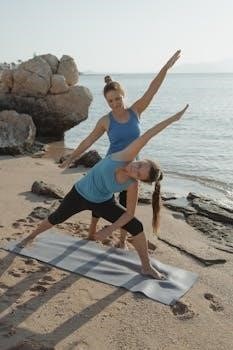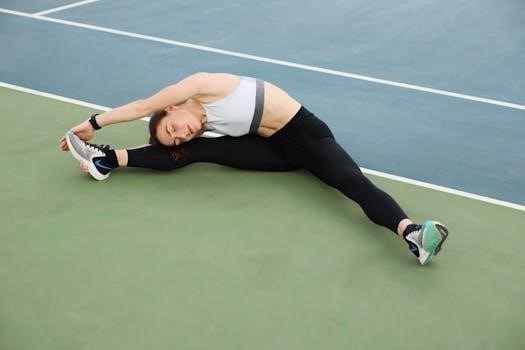Trapezius stretching is essential for relieving tension and pain in the neck, upper back, and shoulders․ Regular stretching improves flexibility, posture, and overall well-being․ Addressing trigger points can alleviate radiating pain, enhancing comfort and function․ Incorporate these exercises into your routine;

Understanding the Trapezius Muscle
The trapezius is a large muscle spanning from the base of the skull to the mid-back and shoulders․ It’s divided into upper, middle, and lower fibers, each supporting different movements․ Understanding its anatomy is crucial for targeted stretching and pain relief․
Anatomy and Function of the Trapezius
The trapezius muscle is a large, superficial muscle that extends from the base of the skull down to the thoracic vertebrae and across the shoulders․ It’s divided into three main sections⁚ upper, middle, and lower fibers․ The upper fibers elevate the scapula, as in shrugging the shoulders, and assist in neck extension and rotation․ These fibers are often tight due to poor posture or stress․ The middle fibers retract the scapula, pulling the shoulder blades together․ This action is important for maintaining good posture and preventing rounded shoulders․
The lower fibers depress the scapula, pulling the shoulder blades downward․ They work in conjunction with the upper fibers to rotate the scapula upward, which is essential for overhead arm movements․ The trapezius muscle also plays a role in stabilizing the scapula, providing a stable base for arm movements․ Trigger points in the trapezius can cause pain in the neck, head, and shoulders, highlighting the importance of regular stretching and exercises to maintain its health and function․ Proper understanding of each section ensures targeted stretches․

Benefits of Trapezius Stretches
Trapezius stretches offer numerous benefits, including relieving neck and upper back pain․ They improve posture, increase flexibility, and reduce muscle tension․ Regular stretching can also alleviate headaches and enhance overall well-being, promoting a healthier, more comfortable lifestyle․
Relieving Neck and Upper Back Pain
Trapezius stretches are highly effective in relieving neck and upper back pain, often caused by muscle tension, poor posture, or prolonged periods of sitting․ The trapezius muscle, which extends from the base of the skull to the mid-back and shoulders, is prone to developing knots and trigger points․ These trigger points can radiate pain into the head, jaw, neck, and shoulders, leading to discomfort and limited mobility․
By regularly performing trapezius stretches, individuals can release this tension and alleviate pain․ Stretching helps to lengthen the muscle fibers, improve blood flow, and reduce the formation of trigger points․ Specific stretches, such as the lateral neck stretch and seated upper trapezius stretch, target different areas of the muscle, providing comprehensive relief․
Furthermore, maintaining proper posture and incorporating these stretches into a daily routine can prevent future pain and discomfort․ Consistent stretching not only addresses existing pain but also promotes long-term muscle health and flexibility․
Improving Posture and Flexibility
Regular trapezius stretches play a crucial role in improving posture and enhancing flexibility․ The trapezius muscle significantly influences shoulder and neck alignment; tightness can lead to poor posture, such as rounded shoulders and forward head posture; Stretching helps counteract these effects by lengthening the muscle fibers and promoting proper alignment․ Improved posture reduces strain on the spine and surrounding muscles, alleviating discomfort and preventing chronic pain․
Furthermore, trapezius stretches increase flexibility in the neck and upper back․ Enhanced flexibility allows for a greater range of motion, making everyday activities easier and more comfortable․ Stretches like the lateral neck and upper trapezius stretch, and the seated upper trapezius stretch, specifically target these areas, promoting suppleness and reducing stiffness․
Incorporating these stretches into a daily routine can lead to noticeable improvements in both posture and flexibility, contributing to overall physical well-being and a reduced risk of musculoskeletal issues․ Consistent practice ensures the trapezius remains flexible and supportive․

Effective Trapezius Stretching Exercises
Several effective exercises target the trapezius muscle to relieve tension and improve flexibility․ These include the lateral neck stretch, seated upper trapezius stretch, and modified bar hang, each designed to target different areas and provide optimal relief․
Lateral Neck and Upper Trapezius Stretch
The lateral neck and upper trapezius stretch is a simple yet effective exercise for releasing tension in the neck and upper back․ To perform this stretch, begin by sitting or standing tall with your shoulders relaxed․ Gently tilt your head towards your right shoulder, bringing your right ear closer to your right shoulder․ You should feel a stretch along the left side of your neck and upper trapezius muscle․
For a deeper stretch, you can gently apply pressure with your right hand on the left side of your head, but avoid pulling forcefully․ Hold the stretch for 20-30 seconds, breathing deeply and relaxing into the position․ Repeat on the opposite side by tilting your head towards your left shoulder and stretching the right side of your neck․ Be mindful of any pain and stop if you feel any discomfort․
This stretch can be modified by slightly rotating your chin towards your chest or towards the ceiling to target different fibers of the trapezius muscle․ Regular practice of this stretch can help improve flexibility, reduce muscle stiffness, and alleviate tension headaches․
Seated Upper Trapezius Stretch
The seated upper trapezius stretch is an excellent way to relieve tension and tightness in the upper back and neck, particularly beneficial for those who spend long hours sitting․ To begin, sit upright in a chair with your feet flat on the floor, ensuring a good posture․ Gently drop your chin towards your chest, feeling a stretch at the back of your neck; Next, lightly place your hands behind your head, interlacing your fingers, and gently pull your head further down towards your chest․
Be cautious not to force the movement; the stretch should be gentle and comfortable․ To deepen the stretch on one side, you can gently turn your head slightly to the right or left while maintaining the downward pull․ Hold this position for 20-30 seconds, breathing deeply and relaxing your shoulders․ Remember to keep your back straight and avoid rounding your spine․
Repeat this stretch several times throughout the day, especially if you experience stiffness or discomfort in your upper trapezius muscles; This simple exercise can help improve flexibility, reduce muscle tension, and promote better posture․
Bar Hang Stretch (Modified)
The modified bar hang stretch is a gentle yet effective exercise for decompressing the spine and stretching the trapezius muscles․ This variation is designed to reduce strain on the shoulders while still providing therapeutic benefits․ Begin by standing in front of a stable horizontal bar, such as a pull-up bar or a sturdy tree branch․ Ensure the bar is high enough that your feet can still touch the ground when you grip it․
Grip the bar with both hands, slightly wider than shoulder-width apart․ Instead of fully hanging, keep your feet in contact with the floor to control the amount of weight on your shoulders․ Allow your body to gently elongate, feeling a stretch in your shoulders, upper back, and trapezius muscles․ Maintain a relaxed posture, letting gravity assist in the stretch․
Hold this position for 20-30 seconds, breathing deeply and evenly․ Avoid tensing your neck or shrugging your shoulders․ Repeat this stretch several times, taking breaks as needed․ This modified bar hang can help improve spinal alignment, reduce muscle tension, and enhance overall flexibility․

Proper Technique and Precautions
Stretching the trapezius effectively requires proper form to prevent injury․ Listen to your body, avoiding pain․ Gentle, controlled movements are key․ Consult a healthcare professional if you have pre-existing conditions․ Maintain consistent breathing and avoid overstretching for optimal safety․
Avoiding Injury During Stretching
To prevent injury while stretching the trapezius, prioritize gentle and controlled movements․ Avoid sudden or jerky motions that can strain the muscles․ Always warm up with light cardio or gentle neck rotations before stretching to increase blood flow and muscle elasticity․ Listen to your body and stop immediately if you feel any sharp or intense pain․ Stretching should produce a mild to moderate sensation of pulling, not pain․ Maintain proper posture and alignment throughout each stretch to ensure you are targeting the trapezius effectively and safely․ If you have any pre-existing neck or shoulder conditions, consult with a healthcare professional or physical therapist before starting a new stretching routine․ They can provide guidance on appropriate exercises and modifications to suit your individual needs․ When performing stretches such as the lateral neck stretch or seated upper trapezius stretch, avoid pulling or forcing your head or neck into a position that causes discomfort․ Use your hand to gently guide the movement, but let the weight of your head do most of the work․ Remember to breathe deeply and evenly throughout each stretch, as holding your breath can increase tension and the risk of injury․ By following these precautions, you can minimize the risk of injury and enjoy the benefits of trapezius stretching safely and effectively․
Holding Time and Repetitions
When performing trapezius stretches, consistency in holding time and repetitions is crucial for maximizing benefits and preventing injury․ Generally, hold each stretch for 15 to 30 seconds to allow the muscle fibers to lengthen and relax․ Avoid bouncing or jerking motions, as these can trigger the stretch reflex and tighten the muscle instead․ Aim for 2 to 3 repetitions of each stretch per session, focusing on controlled and deliberate movements․ It’s better to perform fewer repetitions with proper form than to rush through numerous repetitions with poor technique․ Listen to your body and adjust the holding time and repetitions as needed․ If you’re new to stretching, start with shorter holds (15 seconds) and gradually increase the duration as your flexibility improves․ Similarly, begin with 1 or 2 repetitions and increase to 3 as you become more comfortable․ Consistency is key, so aim to incorporate trapezius stretches into your routine several times per week for optimal results․ Consider stretching daily, especially if you experience chronic neck or upper back tension․ Remember to breathe deeply and evenly throughout each stretch, as this helps to relax the muscles and improve circulation․ If you experience any pain, stop the stretch immediately and consult with a healthcare professional․
